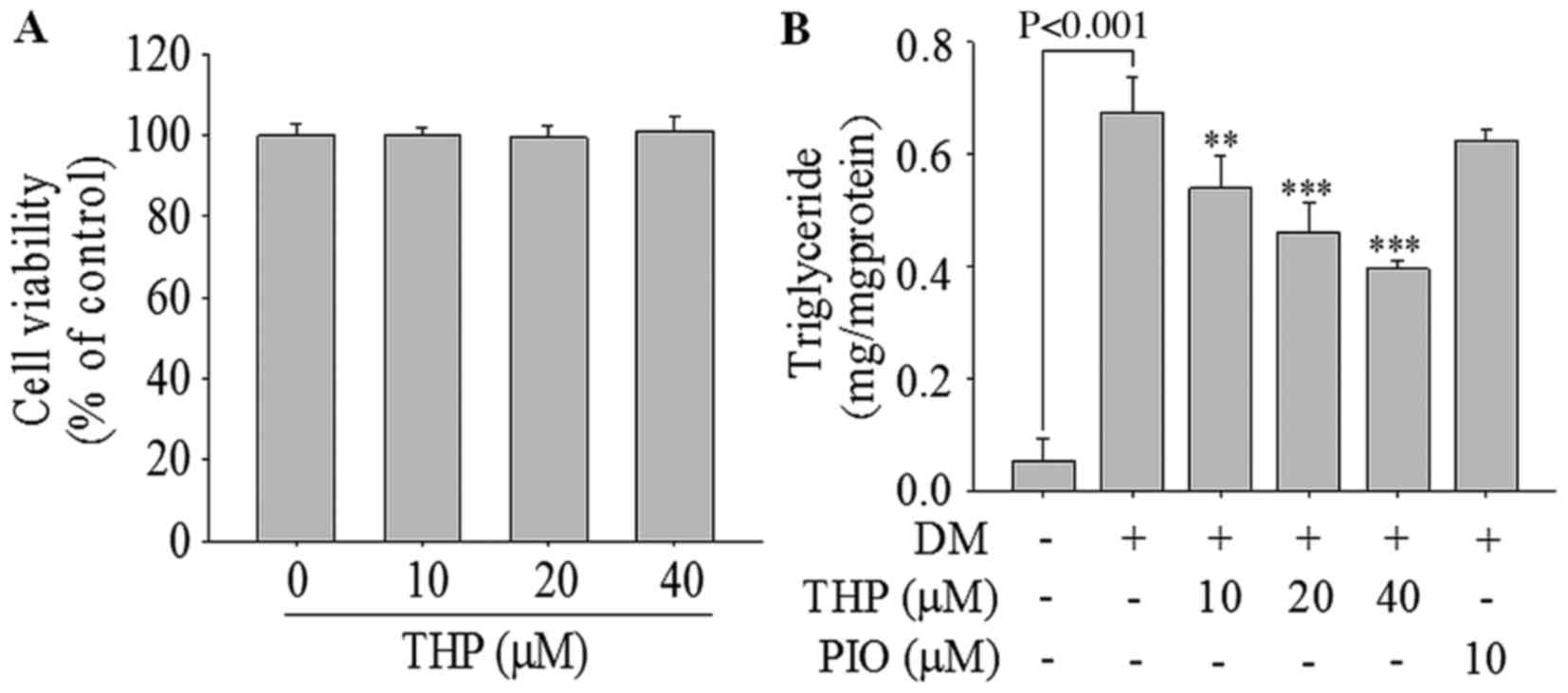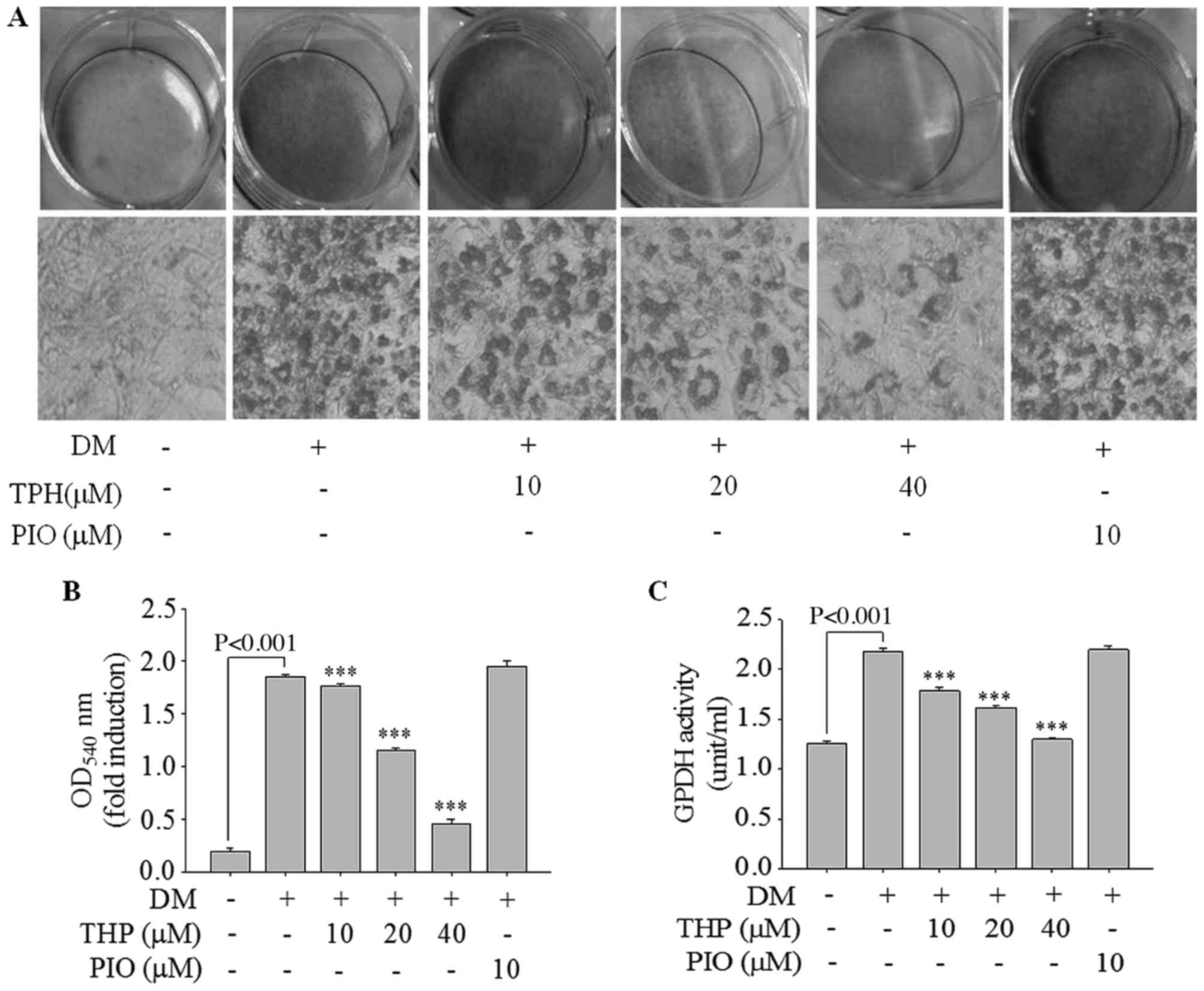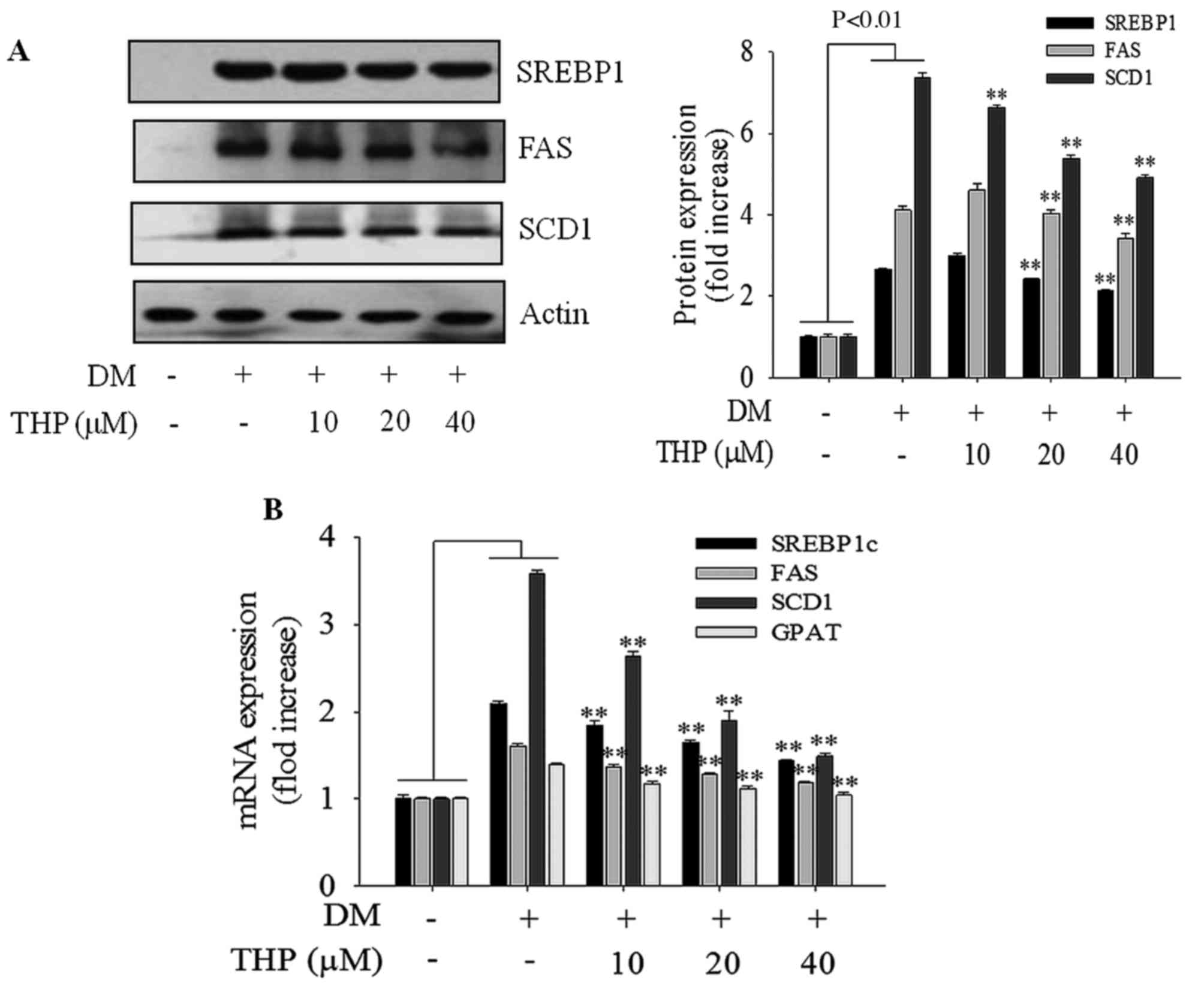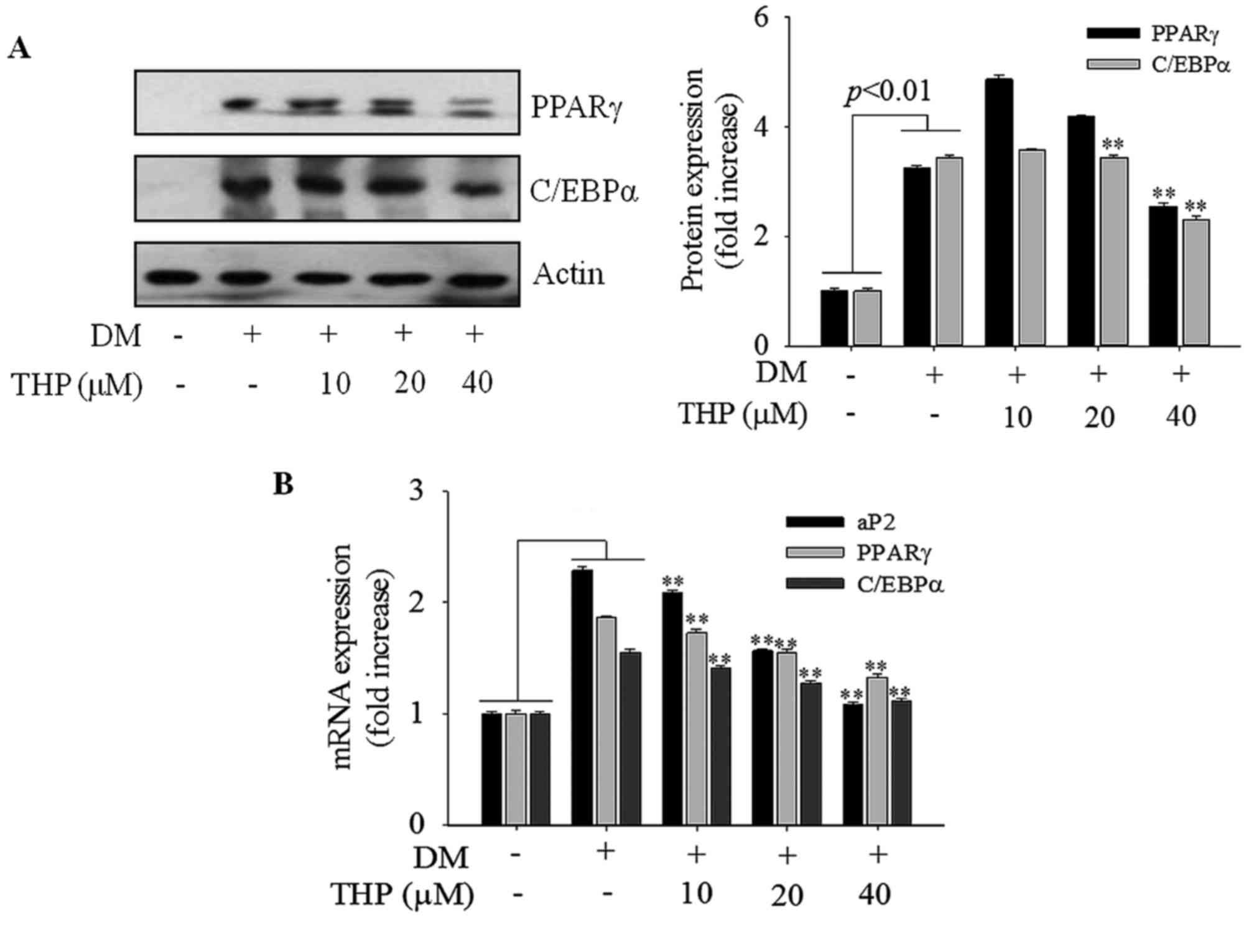|
1
|
Huang B, Yuan HD, Kim DY, Quan HY and
Chung SH: Cinnamaldehyde prevents adipocyte differentiation and
adipogenesis via regulation of peroxisome proliferator-activated
receptor-γ (PPARγ) and AMP-activated protein kinase (AMPK)
pathways. J Agric Food Chem. 59:3666–3673. 2011. View Article : Google Scholar : PubMed/NCBI
|
|
2
|
Yuan HD and Piao GC: An active part of
Artemisia sacrorum Ledeb. Inhibits adipogenesis via the AMPK
signaling pathway in 3T3-L1 adipocytes. Int J Mol Med. 27:531–536.
2011.PubMed/NCBI
|
|
3
|
Kowalska K, Olejnik A, Rychlik J and
Grajek W: Cranberries (Oxycoccus quadripetalus) inhibit lipid
metabolism and modulate leptin and adiponectin secretion in 3T3-L1
adipocytes. Food Chem. 185:383–388. 2015. View Article : Google Scholar : PubMed/NCBI
|
|
4
|
Kim BH, Han S, Lee H, Park CH, Chung YM,
Shin K, Lee HG and Ye SK: Metformin enhances the anti-adipogenic
effects of atorvastatin via modulation of STAT3 and TGF-β/Smad3
signaling. Biochem Biophys Res Commun. 456:173–178. 2015.
View Article : Google Scholar : PubMed/NCBI
|
|
5
|
Kang SI, Shin HS and Kim SJ: Sinensetin
enhances adipogenesis and lipolysis by increasing cyclic adenosine
monophosphate levels in 3T3-L1 adipocytes. Biol Pharm Bull.
38:552–558. 2015. View Article : Google Scholar : PubMed/NCBI
|
|
6
|
Ji S, Doumit ME and Hill RA: Regulation of
Adipogenesis and key adipogenic gene expression by 1,
25-Dihydroxyvitamin D in 3T3-L1 Cells. PLoS One. 10:e01261422015.
View Article : Google Scholar : PubMed/NCBI
|
|
7
|
Kang SW, Kang SI, Shin HS, Yoon SA, Kim
JH, Ko HC and Kim SJ: Sasa quelpaertensis Nakai extract and its
constituent p-coumaric acid inhibit adipogenesis in 3T3-L1 cells
through activation of the AMPK pathway. Food Chem Toxicol.
59:380–385. 2013. View Article : Google Scholar : PubMed/NCBI
|
|
8
|
Ceddia RB: The role of AMP-activated
protein kinase in regulating white adipose tissue metabolism. Mol
Cell Endocrinol. 366:194–203. 2013. View Article : Google Scholar : PubMed/NCBI
|
|
9
|
Wu H, Waldbauer K, Tang L, Xie L, McKinnon
R, Zehl M, Yang H, Xu H and Kopp B: Influence of vinegar and wine
processing on the alkaloid content and composition of the
traditional Chinese medicine Corydalis Rhizoma (Yanhusuo).
Molecules. 19:11487–11504. 2014. View Article : Google Scholar : PubMed/NCBI
|
|
10
|
Yan J, He X, Feng S, Zhai Y, Ma Y, Liang S
and Jin C: Up-regulation on cytochromes P450 in rat mediated by
total alkaloid extract from Corydalis yanhusuo. BMC Complement
Altern Med. 14:3062014. View Article : Google Scholar : PubMed/NCBI
|
|
11
|
Gao JL, He TC, Li YB and Wang YT: A
traditional Chinese medicine formulation consisting of Rhizoma
Corydalis and Rhizoma Curcumae exerts synergistic anti-tumor
activity. Oncol Rep. 22:1077–1083. 2009.PubMed/NCBI
|
|
12
|
Yun KJ, Shin JS, Choi JH, Back NI, Chung
HG and Lee KT: Quaternary alkaloid, pseudocoptisine isolated from
tubers of Corydalis turtschaninovi inhibits LPS-induced nitric
oxide, PGE(2), and pro-inflammatory cytokines production via the
down-regulation of NF-kappaB in RAW 264.7 murine macrophage cells.
Int Immunopharmacol. 9:1323–1331. 2009. View Article : Google Scholar : PubMed/NCBI
|
|
13
|
Chueh FY, Hsieh MT, Chen CF and Lin MT:
DL-tetrahydropalmatine-produced hypotension and bradycardia in rats
through the inhibition of central nervous dopaminergic mechanisms.
Pharmacology. 51:237–244. 1995. View Article : Google Scholar : PubMed/NCBI
|
|
14
|
Lee B, Sur B, Yeom M, Shim I, Lee H and
Hahm DH: L-tetrahydropalmatine ameliorates development of anxiety
and depression-related symptoms induced by single prolonged stress
in rats. Biomol Ther (Seoul). 22:213–222. 2014. View Article : Google Scholar : PubMed/NCBI
|
|
15
|
Zhang M, Liu L, Xiao T and Guo W:
Detection of the expression level of miR-140 using realtime
fluorescent quantitative PCR in knee synovial fluid of
osteoarthritis patients. Zhong Nan Da Xue Xue Bao Yi Xue Ban.
37:1210–1214. 2012.(In Chinese). PubMed/NCBI
|
|
16
|
Kim YS, Lee YM, Kim JH and Kim JS:
Polygonum cuspidatum inhibits pancreatic lipase activity and
adipogenesis via attenuation of lipid accumulation. BMC Complement
Altern Med. 13:2822013. View Article : Google Scholar : PubMed/NCBI
|
|
17
|
Choi SS, Cha BY, Lee YS, Yonezawa T,
Teruya T, Nagai K and Woo JT: Magnolol enhances adipocyte
differentiation and glucose uptake in 3T3-L1 cells. Life Sci.
84:908–914. 2009. View Article : Google Scholar : PubMed/NCBI
|
|
18
|
Wang XL, Zheng Z, Hong Z and Fan G:
Advancements on chemical components and quality control of rhizoma
corydalis. Lishizhen Med Mater Med Res. 22:227–229. 2011.
|
|
19
|
Mcilroy GD, Tammireddy SR, Maskrey BH,
Grant L, Doherty MK, Watson DG, Delibegović M, Whitfield PD and
Mody N: Fenretinide mediated retinoic acid receptor signalling and
inhibition of ceramide biosynthesis regulates adipogenesis, lipid
accumulation, mitochondrial function and nutrient stress signalling
in adipocytes and adipose tissue. Biochem Pharmacol. 100:86–97.
2016. View Article : Google Scholar : PubMed/NCBI
|
|
20
|
Rao Y, Liu H, Gao L, Yu H, Tan JH, Ou TM,
Huang SL, Gu LQ, Ye JM and Huang ZS: Discovery of natural alkaloid
bouchardatine as a novel inhibitor of adipogenesis/lipogenesis in
3T3-L1 adipocytes. Bioorg Med Chem. 23:4719–4727. 2015. View Article : Google Scholar : PubMed/NCBI
|
|
21
|
Farmer SR: Transcriptional control of
adipocyte formation. Cell Metab. 4:263–273. 2006. View Article : Google Scholar : PubMed/NCBI
|
|
22
|
Zhang X, Ji J, Yan G, Wu J, Sun X, Shen J,
Jiang H and Wang H: Sildenafil promotes adipogenesis through a PKG
pathway. Biochem Biophys Res Commun. 396:1054–1059. 2010.
View Article : Google Scholar : PubMed/NCBI
|
|
23
|
Fryer LG and Carling D: AMP-activated
protein kinase and the metabolic syndrome. Biochem Soc Trans.
33:362–366. 2005. View Article : Google Scholar : PubMed/NCBI
|
|
24
|
Kim ED, Kim E, Lee JH and Hyun CK:
Gly-Ala-Gly-Val-Gly-Tyr, a novel synthetic peptide, improves
glucose transport and exerts beneficial lipid metabolic effects in
3T3-L1 adipoctyes. Eur J Pharmacol. 650:479–485. 2011. View Article : Google Scholar : PubMed/NCBI
|
|
25
|
Zhang BB, Zhou G and Li C: AMPK: An
emerging drug target for diabetes and the metabolic syndrome. Cell
Metab. 9:407–416. 2009. View Article : Google Scholar : PubMed/NCBI
|
|
26
|
He Y, Li Y, Zhao T, Wang Y and Sun C:
Ursolic acid inhibits adipogenesis in 3T3-L1 adipocytes through
LKB1/AMPK pathway. PLoS One. 8:e701352013. View Article : Google Scholar : PubMed/NCBI
|














